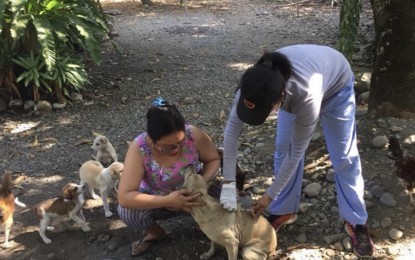
ANTI-RABIES SHOT. A field worker vaccinates a dog against rabies in Ilocos Norte in this undated photo. A massive anti-rabies vaccination has been rolled out in the province after cases were reported in the past few months. (Contributed photo)
LAOAG CITY – Ilocos Norte has stepped up its anti-rabies vaccination drive after two cases were reported in the past few months.
Provincial veterinarian Loida Valenzuela of the Ilocos Norte Provincial Veterinary Office said the cases were recorded in Batac and Badoc.
“Massive anti-rabies vaccination in the affected barangays are now ongoing in Batac City to be followed by Badoc as soon as possible,” Valenzuela said in an interview on Wednesday.
She said the private animal industry sector and the provincial government are both helping provide an "augmentation and counterpart strategy” to procure more vaccines and prevent the spread of rabies.
Meanwhile, Valenzuela reminded pet owners to become responsible and ensure that their pets are kept from stressful situations, such as exposure to hot daytime temperatures or confinement in a cage all day.
Ilocos Norte was earlier named as one of the top-performing local government units for rabies prevention and control, with zero human and canine rabies cases until the lone case recorded in Batac in late 2022.
Records from the National Rabies Prevention and Control program showed that 300 to 600 Filipinos die of rabies every year.
Rabies is a viral disease that causes acute inflammation of the brain in humans and warm-blooded animals, with dogs being the most commonly involved.
Early signs of the viral disease include fever and tingling at the bite site, usually followed by violent excitability, a fear of water, paralysis in some parts of the body, or loss of consciousness.
Once symptoms appear, the disease is nearly fatal, usually manifesting one to three months after the bite. (PNA)
